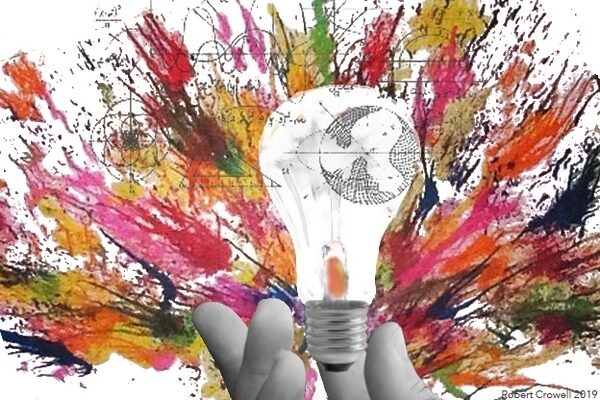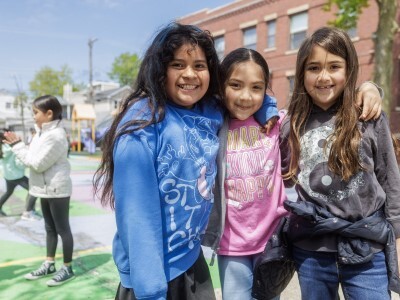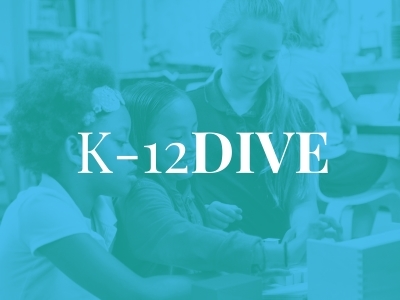Creativity is the Currency of Learning
Topics

Today’s learners face an uncertain present and a rapidly changing future that demand far different skills and knowledge than were needed in the 20th century. We also know so much more about enabling deep, powerful learning than we ever did before. Our collective future depends on how well young people prepare for the challenges and opportunities of 21st-century life.
Tapping into the naturally creative instincts we have as learners can become a powerful motivator that drives learning.
I just love the first few weeks of the new school year! I love it at all levels—preschool, elementary, middle, high, and college. The school environment is electric with excitement as students meet their new teachers, figure out where their classrooms are located, reconnect with friends, and embrace the prospect of new learning. The amount of energy during the first few weeks of the school year at any level is impressive—you can almost feel it in the halls as students and teachers shuffle off to their lessons.
As I visit schools, meet students, and chat with teachers, I often ask them what makes the new school year so exciting. To a person, the response is that the excitement and energy is a result of the anticipation of a new, original experience. When you think about it, the feeling is not unlike the excitement you have when you design new art, perform on stage, play in a sporting event, or go on vacation. All of these events tap into the naturally creative instincts we have as learners. And tapping into this natural instinct can become a powerful motivator—a type of currency that drives learning.
“Creativity doesn’t wait for that perfect moment. It fashions its own perfect moments out of ordinary ones.”
—Bruce Garrabrandt
Creativity Needs Room To Grow
Sadly, the initial sense of excitement during the first few weeks of school does not always sustain as students and teachers settle in for the year. We know that the traditional structures of the past assembly-line type approach to education can often squash any sense of creativity. Indeed, during the No Child Left Behind era in the United States, it was seen as a badge of honor for schools to promote highly scripted learning environments that frowned on crooked lines, high energy students, and creative teachers who developed novel approaches to the learning experience.
There is, however, a revolution brewing in schools across the country where teachers and students are throwing off the shackles of compliance and opening up learning to more authentic, flexible, and, most importantly, creative approaches to education. Heidi Hayes Jacobs really captures this idea in her book Bold Moves for Schools when she invites educators to consider the following: “Breaking set—doing something in a way that differs from the norm—is critical because so much is possible when we explore different options, challenge what we know, and commit to learning more. Breaking set requires bold moves.”
When eager, wide-eyed students at all levels of the system file into the classroom, the opportunity is ripe for educators to take “bold moves” in their pedagogy to tap into the creative energy every student brings. Further, these moves mean more than just how you teach, but when, where, and with whom students learn. Indeed, the learning environment can often be more impactful than the actual lesson. Returning to Heidi Hayes Jacobs, she contends, “In a very real way, the physical plant of a school is a concrete manifestation of pedagogy.” How students interact in space and grouping can become a real game changer in the contemporary learning environment. Change the environment, and you change the behavior. Environments in the 21st century world of work are dramatically different than those of past centuries. I submit to you that our learning environments must keep pace with the ever changing, evolving, and increasingly dynamic environment of the global marketplace.
“Vulnerability is the birthplace of innovation, creativity and change.”
—Brené Brown
Creativity Is a Catalyst for Engagement
Students want to express themselves. It is that simple. And the types of expression are as creative as there are stars in the sky. Sometimes their desire for expression serves as an exemplar for how to act in school, and other times it serves to express their rejection of the system. Either way, there is a whole lot of energy wrapped up in this idea of creative expression. Our traditional model of education was laser focused on wringing out just about every modicum of expression from students in the spirit of compliance and control. This approach dramatically impacted the level of student engagement in school. The Gallup poll has shown, time and again, that the educational system is extremely efficient at sucking the sense of engagement out of students as they move through the grade spans. Specifically, about three quarters of students in fifth grade report to be highly engaged, about half of middle school students report a high sense of engagement, and only about one third of high school students report to be highly engaged.
This disturbing trend does not stop with the students. Only about one third of all teachers report a high level of engagement with their work. Think about that for a moment. That means that six out of every ten teachers do not feel highly engaged in their teaching. I can tell you that every teacher I have come into contact with over the past 30 years wants to be actively engaged in teaching and learning; however, their enthusiasm is often tempered, even snuffed out, when faced with a myriad of procedures, protocols, and compliance expectations.
These statistics from Gallup do not need to be the future. Students and teachers can break out of this doom loop of over-control by encouraging the system to loosen the grip and offer up opportunities that promote a greater level of autonomy over the learning environment and pathway. Daniel Pink, in his book Drive, brilliantly captures how students and teachers feel when they arrive at school when he highlights the danger of creating an environment that is driven by a “carrots and sticks” mentality. In other words, If you come to school, follow all of the rules and get good grades then you will get a great job and become successful—the metaphorical “carrot.” If you come to school but do not follow the rules and do not get good grades, then you will not get a good job and not become successful—the metaphorical “stick.”
Teachers and, more importantly, most students do not respond positively when put onto a conveyor belt of learning. They want to have a level of autonomy over what they learn, a sense of purpose for why they are learning it, and an opportunity to master their learning at a rate that works for them as an individual learner. Allison Zmuda and Bena Kallick, in their book Students at the Center, propose a simple set of four attributes for learning. Teachers and administrators can use them to tap into the unique creativity of all students and teachers, building a learning environment that captures and maintains the enthusiasm and energy of the first few weeks of the school year.
- First, honoring student voice as an authentic part of learning makes learning more personal.
- Second, inviting students to co-create activities and demonstrations of learning ignites engagement because it draws on the unique creativity that all students have and want to use.
- Third, actively engaging students in social construction holds students accountable to constructing meaning with and among others.
- Finally, promoting self-discovery challenges students to jump off the conveyor belt of the past century and into the future where creativity, flexible, and nimble thinking are valuable commodities.
“Creativity is intelligence having fun.”
—Albert Einstein
Creativity Makes Learning Relevant
The best way to improve the learning environment for students is to look beyond education. I always tell my colleagues that most of my professional reading and growth happens outside of the school environment—it is a way to guard against blind spots in my own thinking and work. Recently, I have been spending much of my time checking in with students about their feelings about how the school experience connects to the real world. More often than not, students report that they see no relevant connection between their school experience and the real world. When I ask them about how they tap into their creativity, I am met with great enthusiasm, but the activities almost invariably happen outside of the school environment. I hear things like, developing new skateboard moves, playing in a garage band, taking dancing lessons, playing a sport, playing hours of video games. All of these activities are chock full of creative opportunities and, without exception, require boat loads of energy and engagement.
This begs the question, how might we merge elements of the real world and creative outlets that students naturally have with our learning environments? A unique solution was developed by Ed Hidalgo in partnership with Dr. David Miyashiro and the Cajon Valley Union School District. Together, they created the World of Work (WoW) project. The WoW project infuses real-world experiences directly into the classrooms at all levels. The power of this model comes back to the role of creativity. Every student has unique strengths, interests, and workplace values. Our charge as educators is to set the conditions necessary for all students to discover their strengths, explore their interests, and investigate what they see as valuable in the workplace of today and tomorrow.
When we think about the future of work, the World Economic Forum has outlined the ten most essential skills students need to develop to become successful. Creativity is third on the list. According to a 2019 LinkedIn survey, creativity was the number one soft skill employers are looking for in new employees. Stephan Vincent-Lancrin from the Organization for Economic Cooperation and Development (OECD) has led a four-year project with more than 12 nations, including the United States, to develop rubrics, lesson plans, and activities for teachers and students to use around the world to more fully develop creativity and critical thinking skills. In fact, one of the intended outcomes of this project is to re-bench the world renowned PISA (Programme for International Student Assessment) to include a section on creativity and critical thinking in 2021.
Getting back to the WoW project, the American Student Assistance organization has not only recognized the power of this project in changing the trajectory for students, they are in the initial stages of a grant, working with the Cajon Valley Union School District to scale-up the work. The International Center for Educational Research and Practice (iCERP), by way of Vista Unified, is a proud partner in this important project. iCERP’s singular focus is to work tirelessly to leverage research to inform practice. What we have learned about the impact of creativity to unlock the potential for all students can serve as the new currency for their success as they enter the world of work tomorrow.
“Giving children a better sense of the world of work is not just a matter of social justice, it is also a matter of bringing the potential of the next generation fully to bear.”
—Andreas Schleicher
Image at top by Robert Crowell for Vista Unified School District




